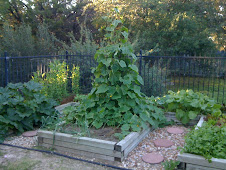

I really like beets so I look forward to when we have them ready in the garden. This year however our fall planted crop did not fare well because we had some very cold temperatures which basically made the beets quit growing. So as an experiment I picked some and boiled them up, peeled and grated them to make a horseradish beet salad. They were a little woody so I guess they will all get yanked and we will plant a spring crop. You may be wondering about the cages. You do not have to cage beets. This is just John's way of trying to keep the cats out of his garden.
What to do with Beets? Well you can grill, roast, boil them or peel and grate them raw. You can also saute the beet tops as greens. To prepare from the garden you will need to pull the beet shaking off any soil so that you keep the soil in the garden. Cut off the tops which you can saute with oil and garlic and onion for a green side if you like.
Grilled Beetsserves 4
3 medium beets
salt, pepper
2 tablespoons olive oil
Peel beets and cut in 1/3 inch slices. Combine with salt pepper and oil in a bowl and mix.
Grill the beets over medium heat until tender just a couple of minutes per side.
Horseradish Beet Saladserves 4
4 medium beets
1/3 cup low fat sour cream
2 tablespoons prepared horseradish (you can use less or more to taste)
1 teaspoon lemon juice
pinch of salt
Remove Beet tops and pointy root. Boil for 20 minutes. Cool and remove skins. They should easily peel off with your fingers. Grate - I usually use a food processor for this task because it can get messy and beet juice will stain. Combine the sour cream, horseradish, salt and lemon juice and add the grated beets. Stir until beets are coated with the sour cream mixture. Serve.
Beet Salad1 or 2 large sliced or julienned peeled and cooked beets – roasted in fireplace or oven at 350 for one hour or boil and peel as above.
½ cup orange juice
¼ cup olive oil
3 tablespoons – rice wine vinegar
Salt
3 tablespoons fresh Mint chopped
Combine all ingredients except beets and whisk to make a vinaigrette then add sliced/julienned roasted beets and coat with the vinaigrette.






